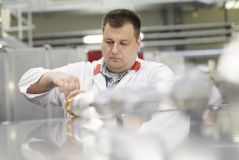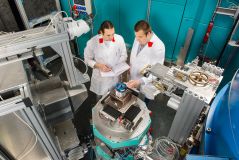MLZ is a cooperation between:
 > Technische Universität München
> Technische Universität München > Helmholtz-Zentrum Hereon
> Helmholtz-Zentrum Hereon
 > Forschungszentrum Jülich
> Forschungszentrum Jülich
MLZ is a member of:
 > LENS
> LENS > ERF-AISBL
> ERF-AISBL
MLZ on social media:

MLZ (eng)
Lichtenbergstr.1
85748 Garching
19.07.2022
Engineered disorder

Disorder in the structure of the electrolyte material leads to higher performance of the battery. © Reiner Müller, FRM II / TUM
New solid-state batteries promise to deliver more energy than their conventional sisters using liquid electrolytes and are attractive for e-mobility because of their longer ranges. A study using neutrons at the MLZ suggests developing a solid electrolyte while intentionally leaving the material disordered. This will lead to higher battery performance.
Recently, lithium thiophosphates have gained attention as a material for solid-state batteries because they are mechanically soft and therefore easy to process. They have high electrolytic conductivity, which means that lithium exchange and transfer occurs more easily.
Jumping between cages of lithium
The ionic conductivity of the material depends strongly on the structural disorder of the negatively charged bromine and sulfur ions. However, it was not entirely clear until now whether and how this disorder affects the distribution of lithium and how it is related to the transport of lithium, which is crucial for improving conductivity. Structural disorder increases with increasing fabrication temperature. Researchers have now frozen the state of disorder using new cooling techniques. Previous studies had examined how chemical composition changes as temperature increases. However, the chemical composition could also have affected the order of the ions. Thanks to the new cooling technique, it is now possible to look at the chemical composition and the disorder of the charged atoms independently of each other.

Dr. Anatoliy Senyshyn examined the samples of the material for solid-state batteries at the structural powder diffractometer SPODI of the MLZ. © Bernhard Ludewig, FRM II / TUM
Researchers from the universities of Giessen, Darmstadt and Münster studied the newly produced and cooled material at the Heinz Maier-Leibnitz Zentrum (MLZ) using neutrons. They showed that the disorder directly affects the lithium ions at the atomic level. “The positively charged lithium ions jump back and forth between so-called cages of bunched lithium ions. With greater disorder, the hopping distances decrease, and at the same time the lithium cages expand, creating more space for the lithium ions to diffuse and increasing the ionic conductivity,” explains Dr. Anatoliy Senyshyn, instrument scientist at MLZ’s SPODI powder diffractometer.
Disorder increases conductivity fourfold
Thus, the greater the disorder, the more lithium is distributed in the battery and the shorter the distances between the positively charged lithium ions. This can lead to a fourfold increase in conductivity, the researchers found. “And higher conductivity means better performance, lower internal resistance and a lower operating load on the entire battery,” Anatoliy Senyshyn summarizes.
Original publication:
A. Gautam, M. Sadowski, M. Ghidiu, N. Minafra, A. Senyshyn, K. Albe, W. G. Zeier, Engineering the Site-Disorder and Lithium Distribution in the Lithium Superionic Argyrodite Li6PS5Br, Adv. Energy Mater., 11, 2003369 (2021)
More information:
In addition to scientists from the Technical University of Munich, researchers from the universities of Giessen, Darmstadt and Münster were also involved in the research work.
The study was funded by the Bundesministerium für Bildung und Forschung (BMBF) within the project FESTBATT under Grant Nos. 03XP0177A and 03XP0174A.
Related News
-
08.06.2022
On the road to the super-battery
-
11.02.2021
Captured lithium
MLZ is a cooperation between:
 > Technische Universität München
> Technische Universität München > Helmholtz-Zentrum Hereon
> Helmholtz-Zentrum Hereon
 > Forschungszentrum Jülich
> Forschungszentrum Jülich
MLZ is a member of:
 > LENS
> LENS > ERF-AISBL
> ERF-AISBL
MLZ on social media:




